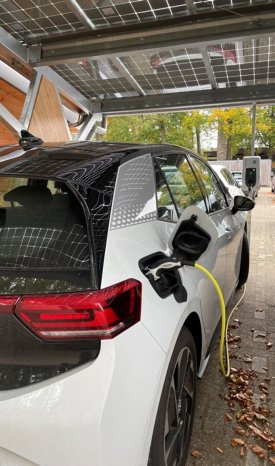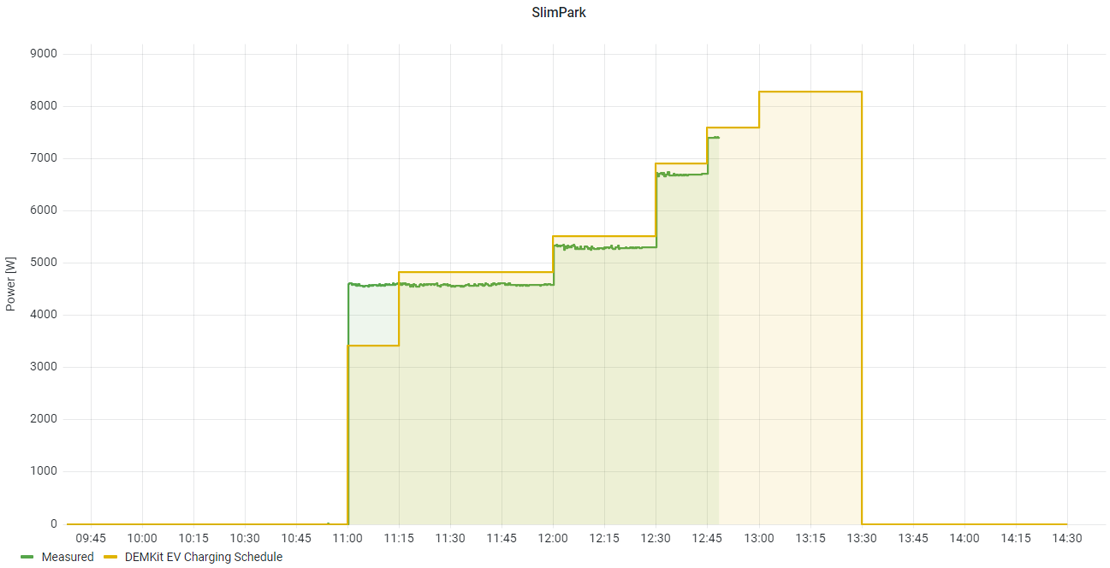As part of the TKI Urban Energy project 'SlimPark', researchers at the University of Twente successfully conducted the first official field test of this project by charging a Volkswagen ID.3 using a smart charging schedule produced by algorithms created by researchers of the Computer Architecture for Embedded Systems (CAES) and Mathematics of Operations Research (MOR) groups.

The test was carried out by requesting a departure time and an energy demand from the electric vehicle (EV) owner. Based on this information, the energy management system calculated the charging profile for the EV. The objective hereby is to charge the EV as much as possible with locally available PV power from the solar rooftop, while satisfying the energy requirement of the EV before the indicated departure time. The used methods for this are the Profile Steering approach, combined with a PV power prediction algorithm (see [1] for details on this algorithm) and an EV charging algorithm using discrete charging levels (approach is based on the research in [2]). All features are fully integrated in the Decentralized Energy Management toolKit (DEMKit), the software tool developed at the University of Twente for research on smart grid technologies.
The image above shows the Volkswagen ID.3 while being charged during the field test. The image below shows an image of the control signal produced by the algorithm (yellow) and the measured charging power (green) during the charging session in progress. The graph shows that the charging does not start with the maximum possible value of 11 kW at arrival in the morning (which would have happened without intelligent control), but that part of the charging is planned to the afternoon, hereby increasing the charging power from approximately 4,6 kW to a maximum of approximately 8,2 kW at moments that there is (more) solar power available. The reason behind this is that now a maximal utilization of the available local PV power is possible and that unnecessary high loads on the public electricity grid are avoided. Hereby it is still ensured that the comfort and wishes of the customer are taken into account.

This first test is the starting point of a field-test with EV drivers at the campus of the University of Twente. The main objective is to implement EV scheduling algorithms that charge as much as possible with locally generated solar energy. For this, on the technical level, the already available algorithms and the energy management system have to be improved. Furthermore, in the social context, research on novel ways of engagement of users with the energy system have to be researched to fully utilize the offered possibilities with smart charging. The ultimate goal of unlocking the available energy flexibility of EVs is to further reduce the carbon footprint of electric driving, while enhancing user comfort and preventing grid congestion. The field test at the campus of the University of Twente will be scaled up further in the next months. For more information about the SlimPark project, visit this page.
[1] Gerards, Marco E. T. ; Hurink, Johann L., "PV Predictions Made Easy: Flexibility Through Simplicity," Proceedings of the 25th International Conference on Electricity Distribution (CIRED 2019). CIRED, 2019. (CIRED Conference Proceedings).
[2] Van der Klauw, Thijs, "Decentralized Energy Management with Profile Steering, Resource Allocation Problems in Energy Management," Enschede, University of Twente, 2017. 221 p.





